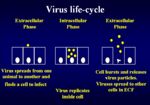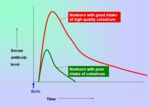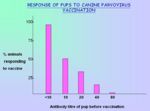Vaccines
| This article has been peer reviewed but is awaiting expert review. If you would like to help with this, please see more information about expert reviewing. |
|
|
Why Vaccinate?
- To protect against infectious diseases
- Where there is no effective treatment once infected
- E.g. FeLV, FIV
- Where disease is life-threatening
- E.g. Canine Parvovirus
- To prevent the spread of disease by virus excretion
- E.g. Rabies, FMDV
- The goal is to vaccinate 90% of the population to reduce the amount of endemic virus until no new infections occur
- Once the disease risk is low, vaccination can be replaced by an eradication or quarantine programme
How do vaccines work?
- Vaccination sets up memory to the viral infection
- High levels of cytotoxic T cells and neutralising antibody are activated in 1-2 days as a secondary response (instead of 4-10 days as a primary response)
- The infection is therefore prevented from taking hold causing lesions to develop
- Neutralising antibody blocks the attachment of virus to host cells receptors
- Endogenous vaccines are where the antigen are made as new proteins by the cell, bacterium or virus
- Involves MHC class I processing
- E.g. live virus, recombinant virus and DNA vaccines
- Exogenous vaccines are when the antigen is processed from the outside by endocytosis without any new proteins being made by the host cell
- involves MHC class II processing
How do we vaccinate?
- Usually by subcutaneous injection for systemic protection (IgG)
- For mucosal immune response, intranasal administration is best (IgA)
What do we vaccinate with?
Passive immunisation
Advantages
- Immediate protection
Disadvantages:
- Short duration of action
- Temporary protection by the administration of preformed antibody from another individual of the same or of a different species
- The aquired antibodies are used in combination with antigen and catabolised by the body meaning protection is gradually lost
- Injection of antiserum may cause an allergic response
- Antiserum contains many antibodies not just the specific antibodies needed
Types of antibodies administered:
- Maternally-derived antibodies in colostrum
- Antiserum (artificial)
- The antibodies are used in combination with antigen (and often an adjuvant) is injected into the host animal
- The immune system of that animal synthesised antibodies
- Repeated injections at intervals increases the total antibody production
- The immunised animal is bled and the serum collected which contains the newly made antibodies. The serum is called antiserum.
- The serum can then be injected into a different animal to confer passive immunisation
- Example of when passive immunisation is used:
- Suspect tetanus
Passive Immunotherapy with Antibody
| INFECTION | HUMAN SOURCE OF ANTIBODY | EQUINE SOURCE OF ANTIBODY | USE |
|---|---|---|---|
| Tetanus Diptheria | Used | Used | Prophylaxis treatment |
| Botulism | Not used | Used | Treatment |
| Venomous bite | Not used | Used | Treatment |
| Rabies | Used | Not used | Post-exposure to vaccine |
Active immunisation
- Administer antigen so the patient develops its own antibodies to protect against disease
- Living organisms
- Dead organisms
- Toxoids
- Subunit antigens
- DNA
Advantages
- Long duration of action
- Once antibody is produced against the antigen, memory cells are formed which continue circulating in the body
- For further information on memory cells click here
Disadvantages
- Delay in protection
- Often needs two or more doses
- The first dose initiates the priming reaction where antibody production ceases after a few weeks, but the second and subsequent doses creates memory cells which remain in the circulation for a much longer period of time
- For further information on the T cell independent and dependent responses click here
What antigen(s) do we use in the vaccine?
Whole Organism
- Live attenuated organism
- Virulent organisms cannot be used as vaccines as they would cause disease
- Virulence is reduced by growing the organism in altered conditions so that it is less able to replicate when introduced to the host and therefore less likely to cause disease
- Produces a superior response to disease than using killed organisms as the dose of antigen is larger and more sustained
- Response takes place at site of natural infection producing a greater local response than with killed organism vaccines
- E.g. The current vaccine for Tuberculosis (called BCG) contains an attenuated form of a mycobacteria
- E.g. Vaccines for Leishmaniasis
- Killed inactivated organism or toxin (toxoid)
- Virulent and toxic organisms cannot be used as vaccines as they would cause disease
- Organisms can be killed using radiation or chemicals so that they still possess the antigens to stimulate an immune response, but the organisms are unable to replicate inside the host
- Toxins are inactivated to produce a toxoid which will still have the antigens needed to produce an immune response but will not be harmful to the host
- Needs two doses (for an explanation on the T cell response click here)
Subunit Vaccine (part of the organism)
- Purified protein
- From lysed organisms
- Recombinant or synthetic protein
- DNA coding for proteins (antigens)
- Can be vaccinated directly into the host
Adjuvants
- Used with vaccines containing inactivated organisms which alone only stimulate a weak immune response
- Some create a depot of antigen at the injection site allowing a steady flow of antigen into the afferent lymph
- Some stimulate the immune system to amplify the adaptive immune response to antigens
- E.g. Pathogen-associated molecular patterns (PAMPs)
- E.g. PAMP-like adjuvants which assist naive T cell priming
- Different subtypes of T helper cells are stimulated by different adjuvants
- E.g. Aluminium salts generate bias T helper II responses for antibody-mediated immunity
- E.g. Killed mycobacteria generate IL-12 producing good cell-mediated immunity
- Adjuvants decrease the number of injection needed and the amount of antigen administered
Which type of vaccine is used for each disease?
- The life-cycle of the organisms needs to be understood to ascertain the best type of immune response for fighting the particular infection
- A vaccine can be created to provide specific immunity which is best suited for fighting the specific infection
Immunity to Virus Infection
- The virus life cycle consists of an extracellular phase, a replicative intracellular phase and another extracellular phase spreading viral particles to other cells to begin the life cycle again
- Immunity for the extracellular phase requires neutralising antibody
- B cells needed
- T helper type II cells needed (for the MHC class II pathway)
- Live vaccine can be used
- Killed vaccine can be used
- Subunit vaccine can be used
- Immunity for the intracellular phase requires CD8+ cytotoxic T cells
- MHC class I pathway
- Only live vaccine can be used to get into cells (entering via the endogenous pathway)
Immunity to Bacterial Infection
- Extracellular bacterial infection need antibody production for opsonisation and to activate the complement pathways
- B cells needed
- T helper type II cells needed
- Vesicular infections can only be cured by organisms being destroyed inside macrophages
- T helper type I cells needed
When do we vaccinate?
- Usually when animals are young
- Breeding females so immunity is passed to offspring via the colostrum
- Protects neonates for the first 8-12 weeks of life
- Vaccination of young animals should be when the natural passive immunity decreases below the threshold for providing protection. Active immunity should then be stimulated so that the animal has constant protection. The vaccination should not be given too early, as the natural immunity can interfere with immunisation by binding and neutralising the vaccine antigens.
- 2 vaccines are usually given to allow for differences between neonates as the point where natural immunity decreases and active immunity needs to be stimulated, will differ between littermates and between different animals
Dog Vaccinations
Diseases covered by Vaccination
- Canine Parvovirus
- Canine Distemper
- Canine Infectious Hepatitis
- Leptospirosis
- Canine Parainfluenza virus
- Kennel Cough
- Rabies
When to Vaccinate
- Puppies are usually first vaccinated between 6 to 8 weeks of age
- A second vaccination is needed 2 weeks later
- Adult dogs need booster vaccination regularly (depending on the specific vaccination)
Cat Vaccinations
Diseases covered by Vaccination
- Feline Infectious Enteritis
- Feline Infectious Respiratory Disease 'Cat Flu'
- Feline Herpesvirus
- Feline Calicivirus
- Feline Leukaemia virus
- Killed whole virus (only used in USA)
- Purified subunit
- Recombinant subunit
- Recombinant canarypox
- Feline Infectious Viraemia
- Killed whole virus containing A and D subtypes (only used in USA)
- Feline Chlamydophilosis
When to Vaccinate
- Kittens are usually vaccinated around 9 weeks old
- A second vaccination is needed 3 weeks later
- Adult cats need booster vaccination regularly (depending on the specific vaccination)
Rabbit Vaccinations
Diseases covered by Vaccination
- Viral Haemorrhagic Disease
When to Vaccinate
- Rabbits can be vaccinated against Myxomatosis from 6 weeks of age
- HVD from 2½ to 3 months of age
- Booster vaccinations are given every 12 months. In areas at high risk of myxomatosis, it is recommended to give myxomatosis boosters at six-monthly intervals.
Links
References
- Ivan Roitt: Essential Immunology, Ninth edition
- Dr Brian Catchpole BVetMed PhD MRCVS






